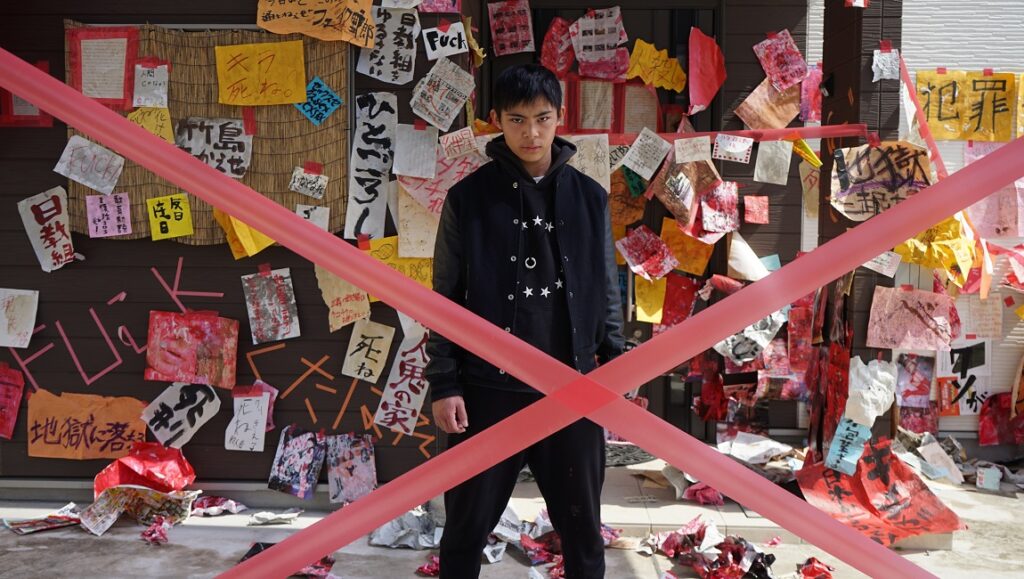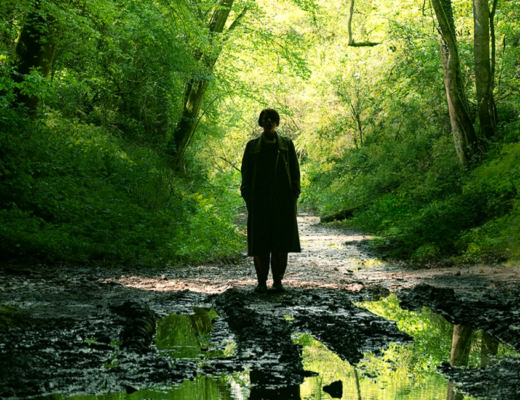Legally Declared Dead
Anthony Wong is an axiom of Hong Kong cinema, an iconic actor who has featured in every conceivable film genre and played every kind of character in his nearly forty-year career. At first blush, the new film Legally Declared Dead looks like a throwback to the Category III exploitation films of the eighties and nineties, glorious monstrosities that saw Wong appear in some of the most famous examples (The Untold Story and Ebola Syndrome, among others). Unfortunately, that’s not what the film is, nor is Wong even the main character (despite receiving top billing). Instead, we follow mild-mannered insurance salesman Yip Wing-shun (Carlos Ka-lok) as he is called to the home of Chu Chung-tak (Wong). Chu’s stepson has hung himself, and Chu is insistent on collecting the insurance payout as quickly as possible. Wong plays Chu as a dumb, lumbering oaf, an impressively intimidating physical performance that stands in stark contrast with his work in last year’s Still Human, where his character was confined to a wheelchair. Eventually, Yip meets Chu’s wife, Shum Tsz-ling (Karena Lam), and becomes convinced that Chu has not only killed his stepson, but is going to target his own wife next. Shum is slowly going blind and walks with a pronounced limp, which Yip fears is the result of domestic violence. The first half of the film allows all of this to unfold at a snail’s pace, as we see Yip’s suspicions grow into outright paranoia.
Director Yuen Kim-wai, adapting a bestseller titled ‘The Black House’, shoots everything like a horror movie; the opening credits are a frenzied blast of weird imagery reminiscent of the beginning of Fincher’s Seven, while Chu and Shum live in a dilapidated flop house that appears to have no working electricity, or windows, or furniture. Scenes of Chu harassing Yip for his payout money take on the ambiance of a slasher film, and Yuen even inserts a couple of ridiculous dream sequences specifically designed to elicit cheap jump scares. Yuen also makes room for flashbacks to Yip’s tragic childhood and deceased younger brother, presumably his motivation to keep a potential maniac from killing again. It’s all very dumb, made worse by playing things relatively straight, but the film becomes more enjoyable as it drops the facade of being an adult thriller and instead embraces its own ludicrous energies. Without spoiling the whole thing, it’s safe to say that the marriage between Chu and Shum is not what it appears to be, and the second half of the film revs up to kidnapping, animal mutilation, torture, and murder. All that makes Legally Declared Dead sound like more fun than it actually is. Far from embracing its more unseemly elements, Yuen cuts away from most of the violence, relying on quick jump cuts and loud music cues to goose the audience. Still, the final showdown between Yip and the real murderer is a solid set piece, finally delivering on the cheap thrills mostly missing from the rest of the film. For undemanding fans of a certain kind of Grand Guignol pot boiler, this is passable if uninspiring entertainment. Daniel Gorman
Forgiven Children
Forgiven Children is a reactionary apologist’s straw man, an irresponsible configuration of centrist thought which aestheticizes and generalizes any viewpoints that would be positioned in opposition to it. A young boy is murdered, and his murderer — another juvenile — goes free, the court system sparing the accused, showing sensitivity for his situation, while also largely discounting the feelings of the victim’s family. Following this, a public campaign is waged against the ruling, and director Eisuke Naito begins to juxtapose a torrent of Netizen’s anonymous comments with shots of untouched nature, in the form of picturesque landscapes. The intent is all too clear: the spectacle and chaos of online culture, and an assumed “unjust” mob mentality is placed in contrast with the beauty and tranquility of the natural world; one corrupts our view, blinds us of the other. The primary agent of this distortion, according to Naito, is bullying — in all its different forms, the suggestion being that to practice this behavior is never, under any circumstance, the ethical course. Naito attempts to illustrate this by showing the film’s murderer, now relocated to a new school, befriending a girl who herself is bullied by her peers. The relationship between these two characters seeks to humanize, to articulate the possibility of rehabilitation via guilt and change. But the girl’s trauma is also used to exploit our sympathy, and then to taunt our moral reaction — if we condemn her tormentors, then surely we must also condemn the actions of the reformed murderer that she’s befriended as well.
Which is to say that this film means to promote the moral viability of redemption — in relation to acts of heightened and aggressive cruelty that leave multiple lives in shambles. Why are we presented with this quandary to consider? Through what perspective does this mean to orient itself, if not reactionary political angst responding, in kind, to the terrible and violent men like Zimmerman and Turner who we’ve rightly been warned about by society — and who’ve also been allowed, by the courts, to walk, their violence gone unpunished by a state that forces our trust to be prescribed. Even as such injustices occur, as the biases of sympathy exist in a structure that fails its victims, Forgiven Children tells us to not get angry, to not seek the social reparation of clearly failing systems of societal order. Naito suggests that these perpetrators’ violence will not go unnoticed by the world, that the ghosts of their victims always linger around them, and that their conscience will be the judge, jury, and executioner…as a substitute for real accountability. Zachary Goldkind
Gone with the Light
It’s unclear if the new film Gone with the Light is directly inspired by or otherwise wholesale lifting the premise of The Leftovers (both the HBO television show and the Tom Perrotta novel of the same name). Whatever the genesis of the film, after similar inciting incidents, it wisely charts a course quite different from its predecessors, and ultimately fails entirely on its own terms. Here, on an otherwise inauspicious weekday morning, a blinding white light blinks a sizable portion of the world’s population out of existence. Those, um, left behind attempt to make sense of this bizarre phenomenon and navigate the new world left in its wake. Director Runnian Dong spends an inexplicable amount of time setting up this premise and then replaying it over and over from the perspective of several different characters. He also prefaces the main event with a faux-documentary opening, as a series of people sit in front of a camera while an offscreen voice asks them how they define ‘true love’. It’s the worst kind of audience hand-holding, stating up front exactly what the film is going to be about and what lens to view the proceedings through. Gone with the Light proffers the suggestion that people disappeared in twos, meaning they were paired-off couples, and that only truly happy people in love were chosen. Ergo, those who remain are either unloved by someone else or incapable of love themselves (honestly it’s not totally clear).
This, of course, sends various relationships into disarray, as we follow mild-mannered school teacher Wu Wenxue (Bo Huang) and his wife, Zhang Yan (Zhuo Tan), their marriage bland and unexciting but otherwise comfortable (or so they thought). There’s also Li Nan (Loudan Wang), who’s in the process of divorcing her unfaithful husband and can’t understand how, or with whom, he might have disappeared, and winds up befriending two of her romantic rivals. And in the film’s most useless subplot, there’s a low-level gangster, Kuaizi (Bai-ke), who thinks a friend of his was murdered just before the white light occurred. There are other characters and plots as well, and Dong returns several times to the documentary framing device, stopping the narrative dead in its tracks to do so. It’s clear that he’s attempting to look at the abstract concept of ‘love’ from every possible angle and, if possible, quantify it in some way. But somehow the film is both overstuffed and interminably dull. There are multiple stories vying for attention, none of which elucidate the others in any meaningful way. Characters pop in and out of the narrative, and Dong can’t find any kind of rhythm in the editing nor can he link them visually. Despite some fine performances and a good faith attempt at tackling a thorny philosophical quandary, the film is flat and inert. Eventually, it seems to settle on the idea that true love comes in many shapes and sizes, and that it’s up to us to define it for ourselves, a self-inflicted wound that renders the previous two-plus hours moot. Daniel Gorman
Chasing Dream
Johnnie To’s Chasing Dream is a return in more ways than one. An earnest romance between an MMA fighter, Tiger (Jacky Heung), and an aspiring singer, Cuckoo (Keru Wang), as their lives and careers become inextricably intertwined, it is the Hong Kong director’s first feature in three years, arriving amid rumors surrounding his as-yet-unproduced Election 3. But the film also harkens, perhaps unexpectedly, to the director’s work from over a decade prior — specifically 2004’s Throw Down. A film about two judo fighters and an aspiring singer, it remains one of the purest expressions of To’s worldview, though depending on one’s general position on the director, it’s probably either a riveting masterpiece or an alienating bore. Chasing Dream is without a doubt the less controlled work: it’s frenetic and overstuffed, mixing and matching styles, tones, and genres with aplomb. If it has an emblematic scene, it’s probably not the grand musical number towards the end — a scene that like Office (2015), teases the viewer with the prospect of a full-blown To musical — but an earlier sequence where Tiger has Cuckoo cycle through a series of recognizable styles (Lady Gaga, Rihanna, Madonna, etc.) while performing her signature song.
But what the film lacks in sophistication it makes up for with sheer exuberance, nonetheless tempered by a certain respect for those that have come before. Throw Down was dedicated to Akira Kurosawa (“the greatest filmmaker”), and Chasing Dream is likewise cognizant of the debt that one owes to one’s forebears and their respective legacies: Cuckoo’s main antagonist is a scheming ex-boyfriend who plagiarized her work on the way to popular success, while Tiger, though faced with the prospect of permanent injury, returns to the MMA ring to avenge his former boxing master. Lit by an array of swinging light bulbs, Tiger’s pre-climax training scene, which gives literal expression to the term shadowboxing, is undoubtedly Chasing Dream’s most visually dazzling sequence. But it also crystallizes the film’s abiding ethos: Watching him move about the remnants of his former life, one gets the sense that there is perhaps no such thing as a “former” teacher, that in boxing or cinema or otherwise, no matter how far one goes in chasing a dream, one cannot escape the shadows of the old masters. Lawrence Garcia
— [Originally published as part of InRO’s 2020 Fantasia Fest coverage.]









